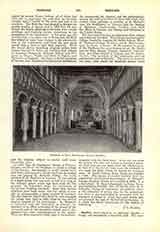

Basilica (stoa basilike, or basileios) signifies a kingly, and secondarily a beautiful, hall. The name indicates the Eastern origin of the building, but it is in the West, above all in Rome, that the finest examples of the basilica are found. Between 184 and 121 B.C. there were built in the Forum at Rome the basilicas of Porcia, Fulvia, Sempronia, and Opimia; after 46 B.C. the great Basilica Julia of Caesar and Augustus was erected. These buildings were designed to beautify the Forum and to be of use both for market purposes and for the administration of justice. They were open to the public and were well lighted. According to Vitruvius, who in this certainly agrees with Greek authorities, the usual construction of a basilica was the following:—
The ground plan was a parallelogram in which the width was not greater than one-half of the length and not less than one-third of it. When there was more space in the length, porticoes were built on the short sides. The middle space was separated by columns from a lower ambulatory or portico; the width of the ambulatory equalled the height of the columns and measured one-third of the width of the central space. Above the columns just mentioned stood others, giving entrance to light, which were shorter and slighter, in order that, as in organic structures, a tapering effect upwards should be given (De architecture, V, i, or ii). A basilica erected by Vitruvius himself showed a decided variation from this plan. It had two ambulatories, one above the other. Part of the columns of the middle space was left free so that light might enter. These columns rose up to the rafters. Pilasters leaning against the columns served to carry the flat roof of the ambulatories. The length of the middle nave was double its breadth and six times the breadth of the ambulatory. One of the long sides of the parallelogram spread out into an apse where legal cases were tried, but it was separated by the width of the ambulatory from the space for merchants (the ancient exchange).
The same writer speaks (VI, viii or v) of half-public basilicas in the houses of distinguished statesmen which served as council-chambers and for the settlement of disputes by arbitration. Vitruvius compares these (VI, v or iii) with the Egyptian halls because the latter had also covered ambulatories around a middle space supported by columns and openings for light between columns above. These are the distinctive features of a basilica which we may venture to define as an oblong structure with columns, having an ambulatory of lower height, receiving light from above, and possessing a projecting addition designed to serve a particular purpose.
The form of the basilica of the early Christian Church corresponds so exactly to the shape of the basilica of the Forum or of the house that it does not seem necessary to seek another model, as for instance, the atrium or the cemetery cells. The dark, narrow temple was entirely unsuited for the holding of the Christian church services. These services, which began with the Last Supper, were often held in large rooms in the dwellings of prosperous Christians. When these facts are considered it cannot be a matter of surprise that as early as the time of Constantine the style and name of the basilica seem to have been in common use for the Christian place of worship. Moreover, the chief deviations from the general type of the ancient basilica, such as five aisles, pillars, angular form of the apse, omission of the portico, etc., have been used as well in the Christian basilica to which the original meaning of the word basilica, “the hall of the king”, could now again be applied.
As a rule, the building at this time was divided into three parts by columns, the well-lighted central part rose higher than the other divisions, and there was an apse. Only, in place of the former surrounding portico, or ambulatory, there was a side aisle to the right and left. There were also basilicas with five and seven aisles. The old construction of the basilica with an apse was well suited to the service of the altar. A transept extending more or less towards both sides was often placed between the nave and the apse both to serve practical needs and on account of its symbolism. The roofing of the transept together with the apse and portico produced variety in the exterior of the basilica. Vaulting, in the West, was used only at times in the side aisles; nothing beyond a flat roof was ventured upon for the very broad middle nave, and often, at the beginning, the rafters of the roof were left uncovered.
It was only after the fifth century that round or square side-towers came into use. These towers were first incorporated in the main building in Syria. The early Christian basilica showed a high, yet light construction, and was roomy and well lighted. The arcades with slender columns which led up to the altar were a particularly beautiful feature. The round form of the arches, of the window-heads, and the ground plan of the basilica were the first indications of the Romanesque style. The idea of a room in which the King of Kings gave audience naturally led to rich ornamentation. The back wall of the apse and the “arch of triumph”, which opened into the transept, were decorated with mosaics. The altar stood in or before, the apse under a decorated baldacchino (ciborium). The walls were often adorned with pictures, and the floor was made of mosaic. Much use was made in the rich churches of beautiful woven stuffs and of fine goldsmith-work. If the employment of these symbols had a tendency to inspire pride, other observances produced humility of mind, as, for example, the symbolic washing at the fountain.
G. GIETMANN

